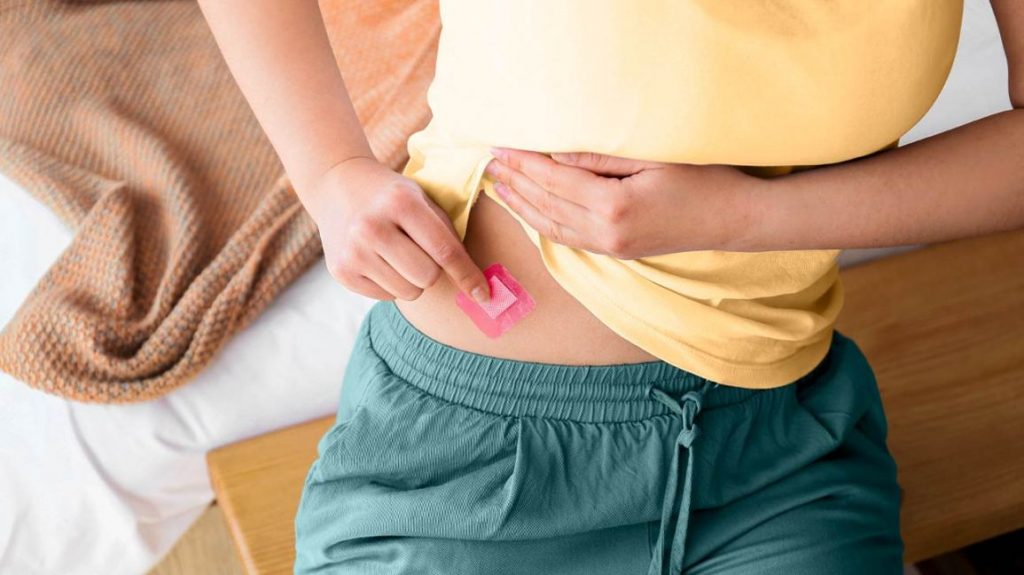-
by admin
Patch
A woman can get pregnant if a man’s sperm reaches one of her eggs (ova). Contraception tries to stop this from happening by keeping the egg and sperm apart, or by stopping egg production. One method of contraception is the patch.
The contraceptive patch is a sticky patch, a bit like a nicotine patch, measuring 5x5cm. It delivers hormones into your body through your skin. In the UK, the patch’s brand name is Evra.
It contains the same hormones as the combined pill, and it works in the same way. This means that it prevents ovulation (the release of an egg); it thickens cervical mucus, which makes it more difficult for sperm to travel through the cervix; and it thins the womb lining, making it less likely that a fertilized egg will implant there.

At a glance: facts about the patch
- When used correctly, the patch is more than 99% effective at preventing pregnancy.
- As humans make mistakes, in real world use at least 8 women in 100 a year become pregnant (92% effective).
- Each patch lasts for one week. You change the patch every week for three weeks, then have a week off without a patch.
- You don’t need to think about it every day, and it’s still effective if you vomit or have diarrhoea.
- You can wear the patch in the bath, in the swimming pool and while playing sports.
- The patch can increase blood pressure, and some women get temporary side effects, such as headaches.
- Some women develop a blood clot when using the patch, but this is rare.
- The patch may protect against ovarian cancer, womb cancer and colon cancer.
- The patch may not be suitable for women who smoke and who are 35 or over, or who weigh 90kg (14 stone) or more.
- The patch does not protect against sexually transmitted infections (STIs), so using a condom as well will help to protect you against STIs.

How the patch works
You can use the contraceptive patch on most areas of your body, as long as the skin is clean, dry, and not very hairy.
You apply a new patch once a week (every seven days) for three weeks, and then stop using the patch for seven days. This is known as your patch-free week. During your patch-free week, you will get a withdrawal bleed, like a period, although this may not always happen.
After seven patch-free days, you apply a new patch and start the four-week cycle again. Start your new cycle even if you are still bleeding.
You should not stick the patch on:
- sore or irritated skin
- anywhere it may get rubbed off by tight clothing
- your breasts
When you first start using the patch, you can vary the position every time you use a new patch to reduce your risk of irritation.
When the patch starts to work
If you start using the patch on the first day of your period, it starts working straight away. This means you can have sex without getting pregnant.
If you start using it on any other day, you need to use an additional form of contraception, such as for the first seven days.
You can talk to your doctor or nurse for more information about when the patch will start to work, and whether you need to use additional contraception.
What to do if the patch falls off
The contraceptive patch is very sticky and should stay on. It should not come off after a shower, bath, hot tub, sauna or swim, or after exercise.
If the patch does fall off, what you need to do depends on how long it has been off, and how many days you had a patch on before it came off.
If the patch has been off for less than 48 hours:
- stick your patch back on as soon as possible (if it is still sticky)
- if it is not sticky, replace it with a new patch (do not try to hold the old patch in place with a plaster or bandage)
- continue to use your patch as normal and change your patch on your normal change day
If the patch has been off for less than 48 hours before you replace it, you will still be protected against pregnancy as long as the patch was on properly for seven days before the patch came off. If this is the case, you do not need to use additional contraception.
If you have had a patch on for six days or less before it falls off, you may not be protected against pregnancy and should use additional contraception, such as condoms, for seven days.
If the patch has been off for 48 hours or more, or you’re not sure how long it has been off:
- apply a new patch as soon as possible and start a new patch cycle (this will now be day one of your new cycle)
- use another form of contraception, such as condoms, for the next seven days
If you had unprotected sex in the previous few days, you may need to see your GP, nurse, local sexual health (GUM) clinic, or pharmacist if you are concerned.
What to do if you forget to take the patch off
If you forget to take the patch off after week one or two, what you need to do depends on how long you have forgotten it.
If it has been on for:
- Less than 48 hours longer than it should have been (eight or nine days in total) – take off the old patch and put on a new one. Continue to use your patch as normal, changing it on your normal change day. You don’t need to use any additional contraception and you are protected against pregnancy.
- 48 hours or more longer than it should have been (10 days or more in total) – start a whole new patch cycle by applying a new patch as soon as possible. This is now week one of the patch cycle and you will have a new day of the week as your start day and change day. Use another method of contraception, such as condoms, for the next seven days. Ask your doctor or nurse for advice if you have had sex in the previous few days and were not using a condom, as you may need emergency contraception.
If you forget to take the patch off after week three, take the patch off as soon as possible and start your patch-free break. Start a new patch on your usual start day, even if you are bleeding. This means that you will not have a full week of patch-free days. You will be protected against pregnancy and do not need to use any additional contraception. You may or may not bleed on patch-free days.
What to do if you forget to put a patch on after the patch-free week
If you forget to put on a patch at the end of the patch-free week, put a new one on as soon as you remember.
If you put the patch on 48 hours late or less (so the patch-free interval has been nine days or less), you will still be protected against pregnancy, as long as you wore the patch correctly before the patch-free interval.
If you put the patch on more than 48 hours late, so the interval has been 10 days or more, you may not be protected against pregnancy and need to use additional contraception, such as condoms, for seven days. Ask your doctor or nurse for advice if you have had sex in the patch-free interval, as you may need emergency contraception.